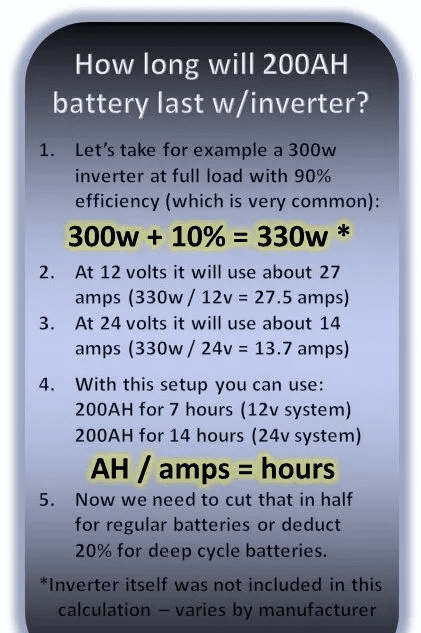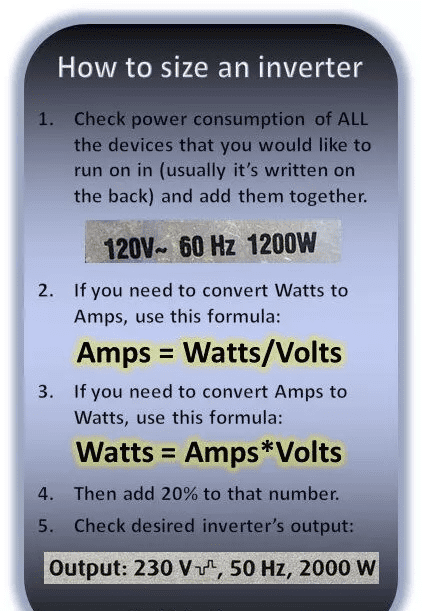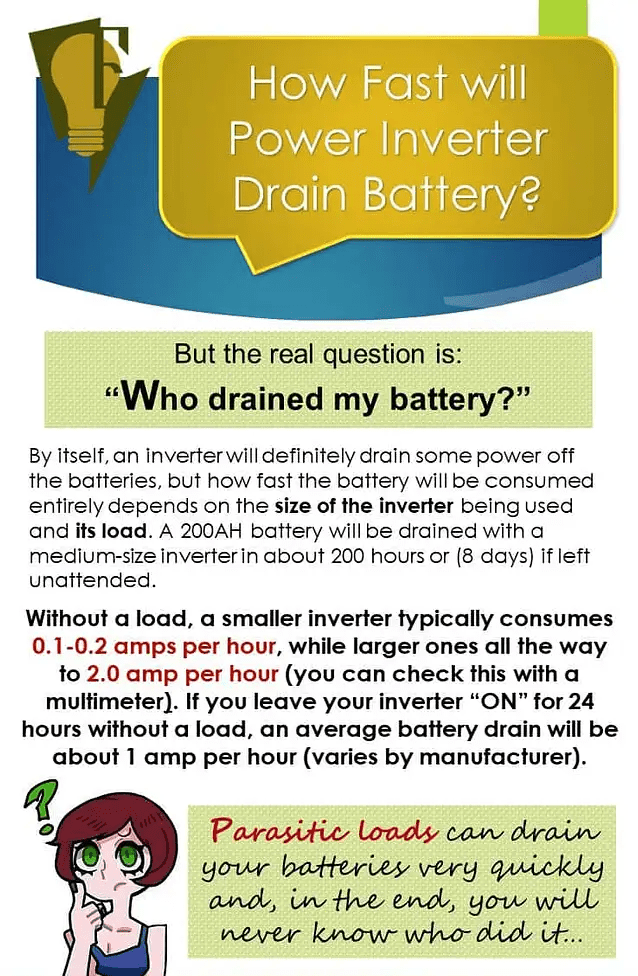Smaller inverters generally use 0.1–0.2 amps per hour without a load, whereas bigger ones may reach 2.0 amps per hour (you can check this with a multimeter).
An average battery loss of roughly 1 amp per hour will occur if you keep your inverter “ON” for 24 hours without a load (varies by manufacturer).
However, the true question is:
“Who took my battery out?”

An inverter by itself will undoubtedly utilize some of the batteries’ power, but the rate at which the battery is depleted totally relies on the size of the inverter being used and its load.
If left alone, a 200AH battery will exhaust with a medium-sized inverter in roughly 200 hours (or 8 days).
You will hear a loud beep when it stops drawing power from the battery, and if you are reading this, it’s likely that you left your inverter running over night and discovered that you were without AC power the next morning.
In the middle of the night, you were probably also informed of this “great” occurrence if your inverter did not have an auto disconnect option.
When the inverter begins to beep, it usually implies that your battery is no longer providing it with sufficient power to carry out its function.
It could be a good idea to get an inverter that cuts power when a low battery level is detected if you are just beginning your inverter shopping.
By doing this, you may prevent your battery from being too discharged, which will ultimately increase the battery’s longevity.
Actually, unless your inverter is quite ancient and has a poor efficiency ratio, everything is probably alright.
Your inverter or batteries may be the wrong size, which would cause an issue.
Before you accuse the inverter of draining your battery, there is one more thing you should know:
There could be more devices linked to the battery that you overlooked.
An inverter converts a DC current (from batteries or solar energy) into an AC current that may be used for AC equipment.
They range in size from from small to large, and their output is often expressed in watts.
You will want a 12-volt converter if, for instance, your RV has a pre-built 12-volt battery system.
The 24- or 48-volt inverter will be a better option for you if you’re constructing a whole off-grid solar system.
The battery will be depleted in accordance with the demands of your plugged-in devices; the inverter’s Watt rating is NOT what decides how much power it consumes.
How much current, for instance, would your 200AH battery need to provide the inverter and 300 watts of load? Here is a summary:

Here is a wonderful video about inverters of various sizes:
Camper-friendly 12V/240V Power Inverters
When attempting to estimate your inverter’s power consumption, bear the following three considerations in mind:
- Level of inverter efficiency.
- Sized inverters
- Load volume
Let’s now go into the specifics!
#1. Efficiency of Inverters
An inverter’s efficiency level serves as a gauge for the amount of power wasted during the conversion of DC current to AC (Alternating Current).
A power factor of roughly 1.1 characterizes the majority of high-quality power inverters now available on the market.
Following is the efficiency formula:
Inverter efficiency is calculated as AC power output (watts) / DC power input (watts) ( percent )
This indicates that your inverter has an efficiency of 90%, or 1.11 “power factor,” if it generates 900 watts of AC power from, say, 1000 watts of incoming DC power.
High-frequency inverters are thought to be more efficient than low-frequency ones, and pure sine wave inverters are often more efficient than modified sine wave inverters.
#2. Inverter Size
The second thing to think about is if your inverter is the right size.
Knowing the size of your load is all that is necessary to size an inverter.

There is some kind of label with watt or amp information on the back of every electronic and electrical item.
You must sum up these figures, translate them into your inverter’s power rating (amps or watts), and allow an additional 20% headroom to appropriately determine the size of your inverter.
If anybody is wondering why there are two power ratings on the inverter rather than just one, it’s because they are different, and only one of them will be utilized to size your inverter:
- Constant power. This is the constant power that will be provided (and your needed rating for calculation).
- Maximum power. This is the amount of power that will be sustained during brief starting spikes (some equipment will state how much surge power they need).

#3. Load Volume
You may use the following formulae to determine how quickly the power inverter will deplete your battery after calculating your load size and your inverter’s efficiency.
You just need to:
Hours are obtained by dividing the battery’s amp hours (AH) by the load’s amps.
Here is a method for getting amps from watts if you’re unsure how to do it:
To obtain amps, divide watts by volts.
You could wish to increase these values by include your efficiency ratio and inverter consumption amps (varies by manufacturer and model).
The battery runtime in hours may be easily calculated using the example below, which is for a 100 AH battery (without efficiency and inverter itself).
Consider how long your equipment will really be in use! We may simply need something for 10 minutes, 30 minutes, or an hour and a half (for example).
You must convert watts to amps before you can begin your computation.
The battery runtime (or hours) is then calculated by dividing AH (amp hours) by amps:
| AC load | AMPs (watts/12v) | 100 AH |
| 50w | 4.16 | 24 h |
| 100w | 8.33 | 12 h |
| 200w | 16.66 | 6 h |
| 500w | 41.66 | 2.4 h |
| 1000w | 83.33 | 1.2 h |
| 1500w | 125.00 | 0.8 h |
| 2000w | 166.66 | 0.6 h |
** Very crucial! The actual timeframes may vary and depend on the battery status, even though these calculations are based on a particular formula.
Additionally, remember to divide the final figure in half to maintain a 50% drain on your battery (unless it is a deep cycle one).
Please feel free to save this infographic as a pin for later use:

You may always check into power monitoring gadgets if you ever become bored of all these computations (another article).
Additionally, you should be mindful of something known as “a parasitic load,” which is a little gadget that your battery is powering without your knowledge (like a smoke or propane detector).
Your batteries may be swiftly depleted by parasitic loads, and you’ll never find out who caused it.










